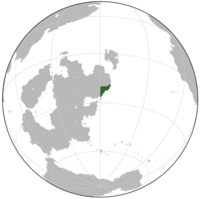Iodaia
State of Iodaia | |
|---|---|
| Anthem: Hope | |
 | |
| Capital | Ioayim |
| Largest city | Irha Aviv |
| Official languages | Odehen Yudipraha |
| Recognised regional languages | Semharan Qalawenan Yawathan Louisiana Creole Kalift Gagian |
| Ethnic groups (2022) |
|
| Religion (2020) |
|
| Demonym(s) | Iodaian |
| Government | Federal parliamentary constitutional republic |
| Ely Deronda Gideon Jacobowitz Rafal Wallach Ofira Shkolnik Vered Schwab Cale Datz Adriyel Wirth | |
| Jerrick Erlich | |
| Kamal Jumblatt | |
| Ben Jannan | |
| Moses Joachim | |
| Legislature | State Parliament |
| Formation | |
| 1391 | |
| 1730-1741 | |
| 1744 | |
• Republic | 29 June 1805 |
| 6 April 1893 | |
| 1985 | |
| Area | |
• Total | 261,950 km2 (101,140 sq mi) |
| Population | |
• 2022 estimate | 29,600,000 |
• 2013 census | 29,512,733 |
• Density | 112.67/km2 (291.8/sq mi) |
| GDP (nominal) | 2022 estimate |
• Total | |
• Per capita | |
| Gini (2022) | low |
| HDI (2022) | very high |
| Currency | Galian Shekel ($) (NGS) |
| Date format | mm-dd-yyyy |
| Driving side | right |
| Calling code | +913 |
| ISO 3166 code | IO |
| Internet TLD | .io |
Iodaia, officially the State of Iodaia, is a country located in the southeast of the Yawatha region of Galia. It is bordered by Temelaeli to the north and New Piedmont to the west. Its eastern and southern coastlines are primarily formed by the Achrinian Ocean and Naossian Gulf. The country controls about 261,950square kilometers of land and is home to 29.6 million people and has the third highest HDI in northern Galia and the largest economy in the Yawatha region. The national capital is the holy city of Ioayim, but the largest city is Irha Aviv.
During the classical era, the region that is now Iodaia was ruled by several empires, some Jewish and some not, with the valuable agricultural land and coastal access being attractive targets of control by competing empires. It would not be until the late 14th century that a unified Iodaian-state would cement itself, with various dynasties and houses vying for control of the elective kingdom. In the 1730s a series of civil wars racked the country, weakening it to such a point it came under the influence of the newly arrived Dilanoyawathans, with outright annexation in the Iodaian War of 1844. Iodaia would exist as a province of Dilanoyawatha until the arrival of the Fluvannians and Gagians and the establishment of Louisiana and New Oshkosh by those empires. In order to form a buffer for their colony after the Galian Colonial War from 1802-1805, the victorious Fluvannians demanded the establishment of an independent republic between what would become New Piedmont and Dilanoyawatha. During the First Great War, Iodaia remained neutral but was invaded during the Second Great War and was forced to pay indeminities to Yawatha and Semhara. Iodaia would side with the Third Coalition and emerged victorious from the war. Postwar reparations culminated with Iodaia participating in the partitioned Semhara with Louisiana and New Piedmont. In contrast to its neighbor, New Piedmont, Iodaia has failed to fully integrate much of its Semharan territory, and an extensive campaign against terrorism and Semharan nationalists is ongoing.
Iodaia is a multi-ethnic state with eight different ethnic groups that have 300,000 people or more. The largest ethnic group is Iodaian Jews. Judaism is the most common faith, though signifigant minorities of Muslims and Polytheists are present. In recent years irreligiousness has been on the rise, especially among young people. Iodaia is a parliamentary democracy based along lines similar to The Furbish Islands with an advanced economy and very high score on the Human Development Index. It is a member of the Trans-Galian Partnership, Global Community, and North Galian Union.

